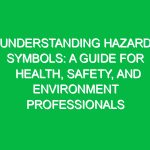Introduction
In the realm of Health, Safety, and Environment (HSE), understanding hazard symbols and signs is crucial for maintaining a safe workplace. These symbols serve as visual aids, conveying essential information about potential risks and necessary precautions in a concise manner. Imagine walking into a chemical storage area and seeing a bright yellow triangle with an exclamation mark. Instantly, you know to approach with caution. Such symbols are not merely decorative; they are vital components of effective safety communication.
The Importance of Hazard Symbols and Signs
Hazard symbols and signs are designed to alert individuals to the presence of hazards and to provide guidance on how to handle them safely. They are universally recognized and help in transcending language barriers, which is particularly important in diverse workplaces. For instance, a red circle with a line through it universally indicates “no”, whether it bans smoking, the use of cell phones, or entry into a restricted area. Understanding these symbols can mean the difference between safety and disaster.
Types of Hazard Symbols
There are various types of hazard symbols, each representing different categories of hazards. Familiarizing yourself with these can help in recognizing potential risks in your environment.
1. Chemical Hazards
Chemical hazard symbols are essential for workplaces that deal with harmful substances. These symbols are typically diamond-shaped and feature images representing the nature of the hazard. For instance, a skull and crossbones symbolize acute toxicity. In a real-life scenario, an employee working in a lab might encounter a chemical labeled with this symbol. Understanding its meaning prompts them to don appropriate personal protective equipment (PPE), such as gloves and goggles, before handling the substance.
2. Biological Hazards
Biological hazard symbols warn of risks associated with biological agents, such as bacteria and viruses. A common symbol features a biohazard sign, which is crucial in healthcare settings. During a hospital internship, I witnessed the importance of this symbol firsthand when staff adhered to strict protocols in areas marked with it, ensuring both patient and employee safety.
3. Physical Hazards
Physical hazards include those that can cause physical harm, such as machinery or electrical equipment. The symbols often depict the nature of the risk, like a lightning bolt for electrical hazards, warning workers to be cautious around live wires. In construction, workers frequently encounter these symbols, and their recognition can prevent potentially fatal accidents.
4. Fire Hazards
Fire hazard symbols indicate the presence of flammable materials or conditions that could lead to a fire. An example is a flame symbol, which warns that a material can ignite easily. Awareness of this symbol is crucial in workplaces like warehouses where flammable substances are stored.
Identifying Hazards and Risks
Every workplace has its unique hazards, and recognizing these risks is the first step in ensuring safety. Hazard symbols play a significant role in this identification process. Here are some common hazards associated with various symbols:
Chemical Exposure
Employees may face exposure to harmful chemicals, leading to respiratory issues, skin irritation, or long-term health effects. For example, a worker in a paint shop might encounter solvents that are harmful if inhaled. Recognizing the hazard symbol on these materials alerts them to use proper ventilation and PPE.
Infectious Diseases
In healthcare settings, biological hazard symbols indicate the presence of infectious materials. Exposure to these can lead to serious health risks, including the spread of diseases. An example is the COVID-19 pandemic, where understanding and adhering to the biohazard protocols became crucial in protecting healthcare workers and patients alike.
Mechanical Injuries
Physical hazards often lead to mechanical injuries. For instance, workers operating heavy machinery must be aware of the risks involved. A caution symbol near machines signifies the need for protective gear and training, which can significantly reduce the risk of accidents.
Safety Precautions and Best Practices
Recognizing hazard symbols is just the beginning. Implementing safety precautions is essential for mitigating risks. Here are several best practices related to hazard symbols and signs:
1. Training and Education
Regular training sessions should be conducted to familiarize employees with hazard symbols and their meanings. This could involve workshops or simulations that reinforce the importance of recognizing and responding to these symbols. For example, a safety drill in a laboratory can help reinforce proper responses to chemical spills.
2. Personal Protective Equipment (PPE)
Always wear the appropriate PPE as indicated by the hazard symbols. This may include gloves, goggles, helmets, or respirators, depending on the identified risks. A personal experience that stands out was during a site visit to a chemical plant where proper PPE use was strictly enforced. This not only protected workers but fostered a culture of safety.
3. Clear Signage
Employers should ensure that hazard symbols are displayed prominently and clearly throughout the workplace. Signage should be regularly inspected and maintained to ensure visibility. Consider a manufacturing facility where clear signs near machinery help prevent accidents and reinforce safety protocols.
4. Emergency Protocols
Establish clear emergency protocols for situations involving hazards. Employees should be well-versed in these protocols, including evacuation routes and first-aid procedures. An incident in a warehouse involving a chemical spill highlighted the importance of having a well-practiced emergency response plan, which minimized injuries and property damage.
Regulations and Standards Governing Hazard Symbols
Several regulations and standards govern the use of hazard symbols and signs, ensuring a consistent approach to workplace safety. One of the most significant is the Globally Harmonized System of Classification and Labelling of Chemicals (GHS), which standardizes hazard communication internationally.
OSHA Standards
In the United States, the Occupational Safety and Health Administration (OSHA) has established guidelines regarding hazard communication. Employers are required to maintain Safety Data Sheets (SDS) for hazardous chemicals and to train employees on understanding these documents and associated hazard symbols.
International Standards
On a global scale, the International Organization for Standardization (ISO) has developed standards that focus on hazard identification and risk assessment. The ISO 7010, for instance, provides a standard set of safety signs to be used across different sectors, promoting consistency and clarity worldwide.
Conclusion
Understanding hazard symbols and signs is not just about compliance; it’s about fostering a culture of safety in the workplace. By recognizing these symbols and adhering to the associated safety precautions, employees can significantly reduce the risk of accidents and injuries. The journey towards a safer workplace begins with awareness and education. Whether you are a seasoned professional or new to the workforce, taking the time to understand hazard symbols can save lives and create a safer environment for everyone.


